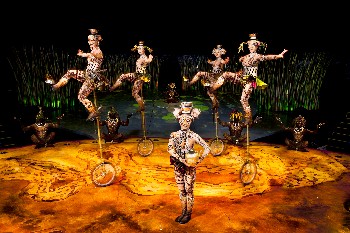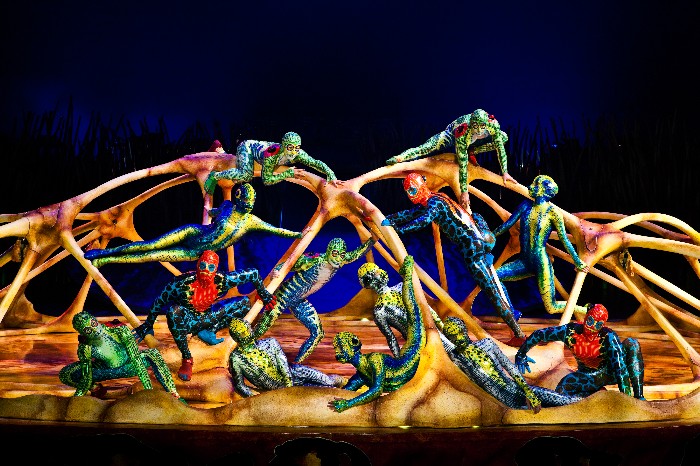Theater Review: A Spectacular Showbiz “Totem” from Cirque du Soleil
Director Robert Lepage’s spectacular projections, aided by a savvy use of sound effects and lighting, move the dramatic focus of Cirque du Soleil’s Totem with ease, opening up the imaginative boundaries of the stage.
Totem. Written and directed by Robert Lepage. Staged by Cirque du Soleil. At the Boston Marine Industrial Park, Boston, MA, through July 22.
By Bill Marx
A once celebrated but now unread critic formulated that poems should “not mean, but be.” I am not sure about poetry, but the adage definitely applies to circuses of vintage and modern varieties. Those looking for a plot, as Mark Twain put it, should be shot.
Still, I had some small hopes that Canada’s director/writer extraordinaire Robert Lepage, whose marvelous The Andersen Project was presented by Arts Emerson this season, might have been able to forge some sort of sensible unity out the astonishing sights and breath-taking physical feats served up by Cirque du Soleil. Totem is billed as “illustrating through a visual and acrobatic language the evolutionary progress of the species.” But, amid all the delight and dazzle provided by this exhibition of the survival-of-the-nimblest, Darwin and his controversial (!?) theory are pretty much a no-show. Few fundamentalists will be riled by Totem‘s playful amalgamation of juggling scientists, glittery beings, amphibian like-creatures, mischievous monkeys, popcorn-munching cavemen, and Amerindians. Intelligent Design should be half so enjoyable.
And does anyone really care that evolution is left out in the cold? The messages in the Cirque du Soleil experience are usually as diaphanous and Euro-kitschy as the show’s music—why weight down an exhilarating, lighter-than-air entertainment?
Ironically, Cirque du Soleil yearns to become heavier. The Fuse has a piece on ART honcho Diane Paulus’s recent attempt in Amaluna to infuse some sort of dramatic shape and emotional development to the Cirque du Soleil formula. The effort to matter more, though intriguing (and handy for generating publicity), is probably not worth all the bother. In the best circuses, each act is a marvelous world in itself. The task of arranging the flashy pools of astonishment into a pleasing order turns the director into a pictorial/spatial choreographer/manipulator, finding ways to move the wondrous action along, act to act, with emotional grace and visual dispatch.
Lepage does this very well in Totem for a couple of reasons. His trademark use of video is used brilliantly via a large, elevated mound in back of the stage, which becomes the site for an expansive range of projections that jump from land and sea to air. In a moment, the setting can change from a volcano to a desert. (A fancy crane called “a Scorpion Bridge” also lifts up out of the mound.) The spectacular images, aided by a savvy use of high quality sound effects and lighting, move the dramatic focus with ease, opening up the imaginative boundaries of the stage. Few Cirque du Soleil productions have been so mobile in terms of morphing through time and space. In fact, it seems to me Lepage could have done even more with the time-worm potential of his projections.
Besides his deft use of video, Lepage has an impish, rather than slapstick, sense of humor, and that has curbed some of the more over-the-top clown business that tends to mar some of the Cirque productions. For me, the humorous interlude in the first half of Totem, a wonderful fishing sketch featuring Mykhaylo Usov, refreshes because it eschews much of the usual hammy overkill (though there is some of that in the show, alas), generating laughs from inventive pantomime capped by a brilliant sight gag that makes perfect use of the visual to make its point—Usov pulls the plunger out of the bottom of a lake, draining out its water. (Could there be a touch of environmental warning to the punch line?)
As for the acts in Totem, they are up to the high, gasp-inducing standards of the Cirque—everyone will have their own favorites. I enjoyed the frogish-attired acrobats sailing with nonchalance around the grips on a huge turtle carapace, which weighs 2,700 pounds and is lifted up into the air for long stretches of the performance. But I was left agog by the quartet of women who, while riding huge unicycles, toss and catch bowls on their heads, the pair of foot jugglers who, while hoisted up in the air, twirl pieces of fabric at supersonic speed on ends of their hands and feet (the pair could make more pizzas in five minutes than most restaurants do all day), the guys perched on their heads on the top of poles, the pair of roller skaters who whip around a small round platform with bat-out-of-hell fury, and the guys that jump and bounce from bar to bar. There are thrills galore—though the subtle drama of the “Fixed Trapeze Duo” (Louis-David Simoneau and Rosalie Ducharme) offers the complete package—a courtship in the sky that marries amazing physical dexterity, strength, and control to a perceptively satiric look at the relationship between a flirtatious couple.
Sometimes the magic is laid on with a trowel of kitsch. The sexpot Amerindian couple in skimpy outfits romancing each other via roller skates is more soft-core campy than erotic. Las Vegas has embraced Cirque du Soleil, and in the process, the latter has absorbed more than a little of Vegas’s flaky flair. But given the opportunity to see derring-do this memorizing, you have to forgive the occasional gauche moves.
Finally, I dearly want to thank Lepage, or somebody on the creative team at Cirque du Soleil, for lowering the volume on the production’s polyglot score. The tunes are the usual incomprehensible concoctions that (to me) sound vaguely like the background chant music for a slick series of virgin sacrifices. But, for once, my ears were not left ringing at the end of the evening. When you worship at this spectacular showbiz Totem, at least you can hear as well as see what in the fantastical world is going on.
Bill Marx is the editor-in-chief of The Arts Fuse. For over three decades, he has written about arts and culture for print, broadcast, and online. He has regularly reviewed theater for National Public Radio Station WBUR and The Boston Globe. He created and edited WBUR Online Arts, a cultural webzine that in 2004 won an Online Journalism Award for Specialty Journalism. In 2007 he created The Arts Fuse, an online magazine dedicated to covering arts and culture in Boston and throughout New England.




I was agog at the depth and range of acrobatic talent under the tent too. Nonethless, I wondered if Cirque, coming out of the deep pool of Canadian circus talent and arts support, had checked with any First Nations people if they found the Pocahantas-and-Brave-Warrior bodice ripper on roller skates offensive. Frogs and chimps, of course, don’t get to vote about their Lepage portrayals (hey, neither do Valkyries) but this number got a little too close to the discredited museum trend of presenting “primitive peoples” as part of Natural History for me.
I mentioned the Vegas cheesiness in my review — I didn’t say that this act (with its peek-a-boo costuming and heavy breathing) was obviously put in to offer a little eye candy for the “tired businessman” crowd. Hard for me to believe that Lepage came up with this overheated number — but who says artistic evolution always moves forward?
The Fixed trapeze is supposed to be youthful love, while the married duo who do the roller act represent mature love. Since there are both First Nations people of Canada and Amerindians in the actual show, they obviously approve.